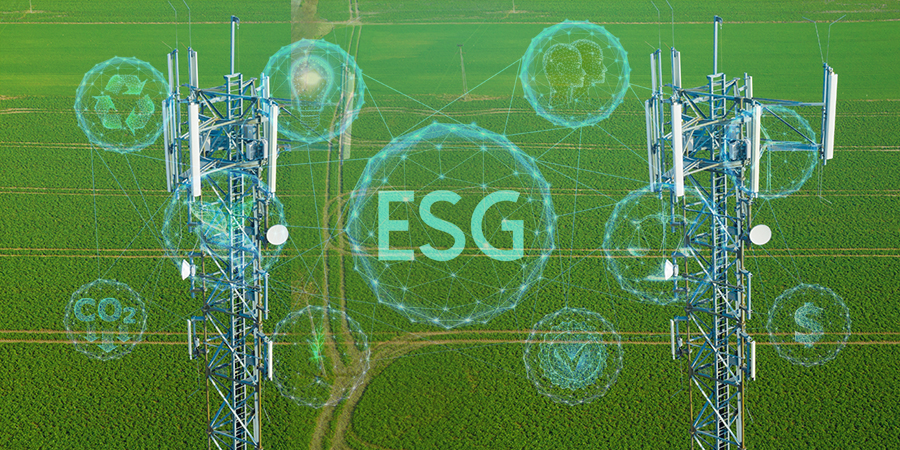As a key industry in an increasingly digitized and sustainability-conscious economy, it becomes imperative for the ICT industry, the telecom sector in particular, to be compliant with the regulations and policies driving the decision-making in the industry and the overall global market.
As such, environmental, social and governance (ESG) targets are becoming crucial for telcos to attract investments as well as retain loyal customers and employees. Investors, customers and employees are increasingly assessing the company’s level of sustainability mainly through the three criteria listed below:
- Environmental: Company’s direct impact on the natural environment and how energy-efficient they are.
- Social: Company’s interaction with customers, stakeholders and communities at large.
- Governance: Company’s approach to leadership, demographics and internal controls.
Furthermore, market intelligence predicts that the value of ESG exchange-traded funds will increase from $35 trillion in 2020 to $50 trillion by 2025, representing a third of the projected total global assets under management. In a survey of 200 asset owners conducted by Morgan Stanley Capital Investments (MSCI), 62% cited climate change or ESG measurement as a top 3 impactful trend in the next 3–5 years, and 73% planned to increase ESG investment either significantly or moderately.
How Will IoT Play a Role in This?
By now, most of us are familiar with the term “IoT,” or “Internet of Things.” It is perhaps one of the most interesting innovations in the technological advancements taking place today. IoT incorporates physical objects with sensors, processing abilities, software and other technologies that connect and exchange data with other devices and systems over the Internet or other communications networks. For instance, paying for your groceries through the debit card embedded in your mobile phone or calling a friend using your wristwatch instead of your phone are some of the top-of-mind examples of IoT at play.
Thanks to the convergence of multiple technologies, IoT has evolved to encompass ubiquitous computing, commodity sensors and powerful embedded systems, as well as machine learning and artificial intelligence that complement various industry operations. These may include sectors such as utility, transportation, healthcare, heavy industries and so on. IoT technology has been instrumental in the concept of smart homes, smart cities and smart factories. The technology is rapidly being adopted for applications in automobiles as well as aviation.
Some of the latest IoT deployments for energy-efficient operations include the following:
Industrial IoT (IIoT): An extension of IoT, IIoT applications facilitate connectivity between machines and devices in such industries as oil and gas, utilities and manufacturing, health, etc. Downtimes and system failures in such industries are a matter of grave concern for their productivity and reputation. IIoT applications are deployed to improve operational efficiency and equipment maintenance, as well as for health and safety purposes.
Enterprise Networks: The network is the pillar of any modern enterprise business operations. The absence of efficient connectivity would simply mean disruptions in the flow of information for companies operating globally. IoT applications in enterprise networks can provide marked efficiency in connectivity, device management, security and services.
Residential Broadband: A massive amount of online activity takes place from the residential customer’s end. IoT helps deliver sustainable networks that continually adapt to the varied needs of home users, resulting in lower energy consumption and value-added, customized services.
Smart Metering: IoT has enabled smart metering that facilitates efficient management of utility services such as water and electricity, allowing both utility companies and their consumers to benefit from the many advantages. Some of the advantages of smart metering include efficient energy use, timely servicing and repairing of utility infrastructure, and improved compliance with regulations.
Opportunities to Tap
IoT deployment can open up a vast array of opportunities for telecom operators to channel their ESG initiative by enabling other sectors to minimize energy consumption. They must find ways to increase their role within the IoT ecosystem and capture a larger proportion of the revenue potential linked with IoT deployments beyond the connectivity and network management layers of an IoT value chain by offering solutions such as Platforms as a Service (PaaS) for developers, as well as cloud and analytics solutions geared towards IoT projects. For instance, Ooredoo Qatar launched an IoT platform that enabled application development and connected device management for enterprises, along with real-time analytics and device security. Additionally, in the UAE, Etisalat and Orange have established an IPX peering point at Etisalat’s SmartHub PoP to improve its international wholesale arm’s range across partners in the region and meet capacity demand for 4G and 5G connectivity. The Etisalat SmartHub/IPX peering platform addresses both roaming customers and IoT roaming businesses that require low latency.
Challenges Remain
The IoT has the potential to transform business models by changing how organizations gather data and information by bringing together the major technical and business trends of mobility, automation and data analytics.
Despite the benefits, IoT will need adequate and affordable wireless connectivity, interoperability and common standards to be successful. IoT ecosystem design will need to focus on security, reliability, scalability, latency and the level of individual control of connectivity parameters. Since IoT is the storehouse of sensitive personal information, privacy and security of confidential data will remain a key area of concern. Another area of concern is the integration of IoT with existing technologies. All devices will need to tweak their architecture to connect to cloud services and other gadgets, resulting in increased complexity to connect to everyday objects. Last but not least, internet connectivity to access and use IoT applications is not equal in all parts of the world. Without collaborative and concerted efforts to bring the unconnected into the fold, the implementation of IoT will sadly remain an exclusive technology for the few.









